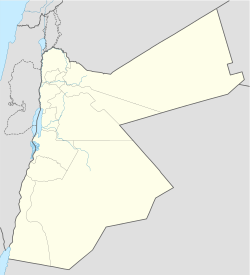Qasr al-Hallabat (Arabic: قصر الحلابات) is an Umayyad desert castle, with the associated bath house of Hammam as-Sarah east of it. The nearby modern town, named after the castle, is part of the Zarqa Governorate of north-western Jordan, north-east of the capital of Amman.[1]
Qasr al-Hallabat
قصر الحلابات | |
|---|---|
 Rebuilt mosque (left) and qasr (right) | |
| Coordinates: 32°5′00″N 36°21′47″E / 32.08333°N 36.36306°E | |
| Country | |
| Governorate | Zarqa Governorate |
| Time zone | UTC + 2 |
History
editThe complex of Qasr al-Hallabat is located in Jordan's eastern desert.[2] Originally a Roman structure constructed in the 2nd-3rd century AD to protect the eastern frontiers of the Roman Empire, although there is trace evidence of Nabatean presence at the site.[2] It was one fort of many on the Roman highway, Via Nova Traiana, a route that connected Damascus to Aila (modern-day Aqaba) by way of Petra and Philadelphia (modern-day Amman).[2]
In the 6th century, the fort was ceded to the Ghassanids as part of the foedus treaty with the Byzantine emperor Justinian. The Ghassanids significantly altered the structure and constructed a monastery.[3]
By the 8th century, the Umayyad caliph Hisham ibn Abd al-Malik ordered the structures to be demolished in order to redevelop this military site and its neighboring territory to become one of the grandest of all Umayyad desert complexes.[2]
Umayyad complex
editGuided by the extant plan,[dubious – discuss] Hisham incorporated a mosque (situated 15 meters southeast of the main structure), a complicated water system including five cisterns and a considerably large water reservoir, and a bathhouse.[2] Furthermore, situated to the west of the palace remains an enclosed structure probably used for agricultural purposes such as cultivating olive trees and/or grapevines, of which only a one-layered stone footprint is still standing.[2]
Qasr
editThe main palace is built of dark and light stone, basalt and limestone, and has a square floor plan with towers at each corner.[2] Grand in stature, the principal structures were further enhanced with decorative mosaics depicting an assortment of animals, detailed frescoes and highly crafted stucco carvings.[2] The site remains to be completely restored.[dubious – discuss][2]
Mosque
editApproximately some 14 meters southeast of the palace stand the remains of the mosque.[2] Small in scale, it measures 10.70 by 11.80 meters and is constructed of layered limestone.[2] Inside, two arching riwaqs[clarification needed] divide the mosque into three sections.[2] A rounded molding extends the perimeter of the space at the height of 2.10 meters.[2] Similar to Qusayr 'Amra and Hammam as-Sarah, three barrel vaults support the roof of the structure. Encircling the mosque from the north, west, and east stood a 3.30-meter wide portico.[2]
Of the mosque, three wall sections, including the mihrab in the southern wall, remained intact from the original structure.[2] Recent reconstruction works have added back the collapsed[clarification needed] elements.[citation needed]
Gallery
edit-
Mosque (front view) after being largely rebuilt, Mihrab is visible in the interior back wall
-
Entrance courtyard
-
Mosaic floor at the castle
-
Greek inscription on basalt block in secondary use
Modern town
editThe nearby modern town of Qasr Al-Hallabat is a municipality consisting of four villages. The area is inhabited by the Bani Sakhr tribe, especially the Al-Othman family.
See also
editReferences
edit- ^ Maplandia world gazetteer
- ^ a b c d e f g h i j k l m n o ArchNet entry for Qasr al-Hallabat and Qasr as-Sarah. "Qasr al-Hallabat". ArchNet. Aga Khan Trust with MIT. Archived from the original on 16 June 2016. Retrieved 10 August 2009.
- ^ Perry, Megan; Parker, Kathryn; Montgomery, R. Taylor (2015). "An Early Islamic Homicide at Qasr Hallabat, Jordan". Near Eastern Archaeology. 78 (4): 274–284. doi:10.5615/neareastarch.78.4.0274. ISSN 1094-2076. JSTOR 10.5615/neareastarch.78.4.0274.
External links
edit- A history of the excavation of Qasr al-Hallabat Archived 2010-01-03 at the Wayback Machine
- Photos of Qasr al-Hallabat, The American Center of Oriental Research (ACOR)
- Photos of Qasr al-Hallabat at the Manar al-Athar photo archive
